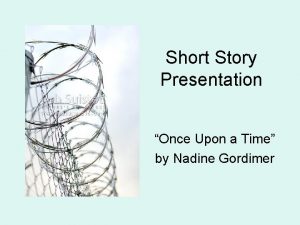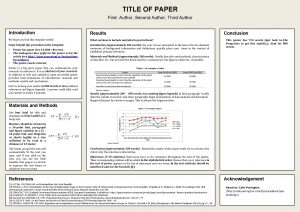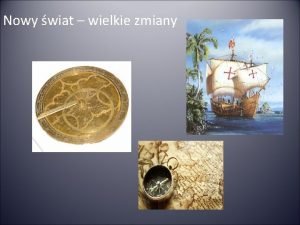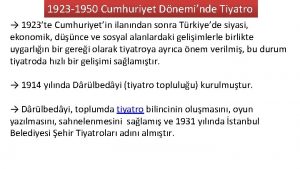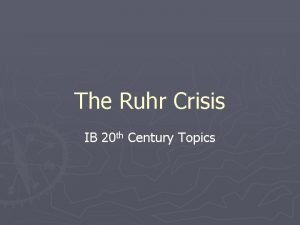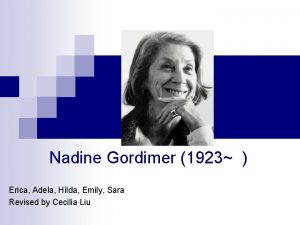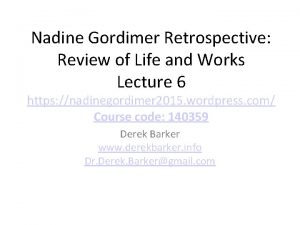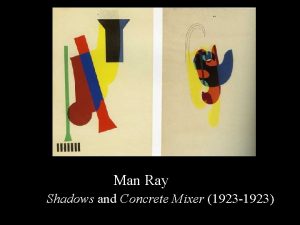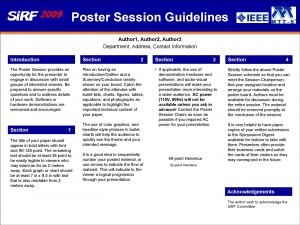Allesverloren Nadine Gordimer The Author Nadine Gordimer 1923



















- Slides: 19

Allesverloren Nadine Gordimer

The Author: Nadine Gordimer • • 1923 -2014 South African writer, political activist and recipient of the 1991 Nobel Prize in Literature. Main issues in her writings: racial issues, apartheid and social issues. The arrest of her best friend, Bettie du Toit, in 1960 and the Sharpeville massacre spurred Gordimer's entry into the antiapartheid movement. Thereafter, she quickly became active in South African politics, and was close friends with Nelson Mandela's defence attorneys (Bram Fischer and George Bizos) during his 1962 trial.

• • • Gordimer was born near Springs, Gauteng, an East Rand mining town outside Johannesburg. Her father, Isidore Gordimer, was a Jewish immigrant watchmaker from Žagarė (then Russian Empire, now Lithuania), and her mother, Hannah "Nan" (Myers) Gordimer, was from London. Her mother was from an assimilated family of Jewish origins; Gordimer was raised in a secular household. She attended a Catholic convent school, but was mostly home schooled because her mother feared Nadine had a weak heart. This isolation made Gordimer start writing at a very young age.

The Story: Allesverloren • • The story is part of a short story collection called Beethoven Was One- Sixteenth Black (2007). The collection was praised for its combination of intimacy and transcendence, as well as “tact. ”

Let’s have a look at these images and describe what you see and how you feel:



What part of the story do these images represent? The Introduction? • The Events? • The Climax? • The Resolution? •

The Introduction is very clear in this story, up to which point is the story being “introduced”? Find punctuation, grammar or visual cues that show us where the Introduction ends. • In the Intro. , Gordimer uses several images and metaphors to show the protagonist feels. Can you find these in the story? • Choose 3 quotes from the Introduction that you consider relevant. Paraphrase these 3 quotes. •

Allusions • • Right before the Introduction finishes, there is an important allusion to a poem. Can you find it? How do you think this relates to the story? Why did the author choose to include this quote? And why is it in the Introduction to the story?

Death Poem by W. B Yeats NOR dread nor hope attend A dying animal; A man awaits his end Dreading and hoping all; Many times he died, Many times rose again. A great man in his pride Confronting murderous men Casts derision upon Supersession of breath; He knows death to the bone -Man has created death

Death Poem • • What comparison is the poem presenting to the reader? What feelings does the poem convey? What’s the importance of the words “dread” and “hope”? Why do you think Yeats says man “knows death to the bone” and that man “has created death”?

General Comprehension Questions • • Discuss these questions in pairs to then share with the class: 1) What “secret” did the man tell the woman when they started their relationship? 2) Explain the use of the word “unnatural” to describe the man’s affair. 3) What were the occupations of the three characters of the story? Do you think these occupations were chosen at random or for a reason? Explain your views. 4) At some point in the story, the woman thinks about an “unwritten” letter she would have sent to the photographer. Think about what you think the woman would have said in this letter. 5) Find the instances in the story where Africa (or anything related to it) is mentioned. 6) The long awaited conversation between the photographer and the woman is supposed to be superficial, “nothing personal”. To what extent is this true? What happens?

What’s in a name? • • • Why do you think that Gordimer doesn’t reveal the names of the characters at the very beginning of the story? In fact, Marc’s name is only mentioned once, whereas Hayford (the photographer) is mentioned the most. What about the woman? Why doesn’t the reader have access to her name? Had you not been given any name, do you think the story would have changed at all?

Working with quotes to better understand the story • Let’s consider the following quotes and discuss their meaning(s).

• • “There was love and there is love, but only on one side; the reciprocal recipient is gone. Gone? ” (p. 56) “But now that her man can exist for her survival only through piecing him together in what is available for recall, there is a gap – yes, a blankout. She can make the re-creation for herself whole only if she can recall what is not hers to recall. ” (p. 58) “It’s always a problem to get people – other people – to understand the kind of commune of gays. ” (p. 64) “You know the one you knew. Cannot know the other, any other. Allesverloren. ” (p. 66)

Stages of Grief • The Swiss Psychiatrist, Elisabeth Kübler-Ross classified Grief in 5 stages:


Journal Entry #2 • Write a short paragraph about any of these options: 1) Imagine you are the woman of the story and write the letter you would like Hayford to read. 2) Continue the story from where it ends. 3) Write a short reaction poem to the feelings of “Grief” and “Death”. 4) Make a drawing of a part of the story that you enjoyed. • BE READY TO SHARE WHAT YOU’VE DONE WITH YOUR CLASSMATES! • •
 Summary of the chip of glass ruby
Summary of the chip of glass ruby Once upon a time by nadine gordimer
Once upon a time by nadine gordimer Nadine gordimer works
Nadine gordimer works Once upon a time short story
Once upon a time short story First author second author third author
First author second author third author Ruhrkampf verlauf
Ruhrkampf verlauf O ego e o id (1923 resumo)
O ego e o id (1923 resumo) Riforma gentile 1923
Riforma gentile 1923 Fms movie
Fms movie Ben day dots stencil
Ben day dots stencil Henryk żeglarz ur 1923
Henryk żeglarz ur 1923 Lei eloy chaves
Lei eloy chaves 1923cmp
1923cmp 1923 1924
1923 1924 Aqui hay sabiduria entendimiento cuente numero bestia
Aqui hay sabiduria entendimiento cuente numero bestia Auto dealer compliance training
Auto dealer compliance training Cumhuriyet dönemi'nde tiyatro 1923 1950
Cumhuriyet dönemi'nde tiyatro 1923 1950 Ruhr crisis 1923
Ruhr crisis 1923 Các châu lục và đại dương trên thế giới
Các châu lục và đại dương trên thế giới Cách giải mật thư tọa độ
Cách giải mật thư tọa độ



